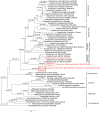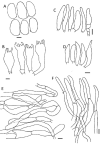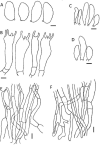Three new species of Inosperma (Agaricales, Inocybaceae) from Tropical Africa
- PMID: 33551659
- PMCID: PMC7862217
- DOI: 10.3897/mycokeys.77.60084
Three new species of Inosperma (Agaricales, Inocybaceae) from Tropical Africa
Abstract
Here, we describe three new species of Inosperma from Tropical Africa: Inosperma africanum, I. bulbomarginatum and I. flavobrunneum. Morphological and molecular data show that these species have not been described before, hence need to be described as new. The phylogenetic placements of these species were inferred, based on molecular evidence from sequences of 28S and RPB2. Additional analysis using ITS dataset shows interspecific variation between each species. Phylogenetic analyses resolve I. flavobrunneum in Old World Tropical clade 1 with weak support, I. bulbomarginatum is sister of Old World Tropical clade 1 and I. africanum is indicated as sister to the rest of Inosperma. Complete description and illustrations, including photographs and line drawings, are presented for each species. A new combination of Inocybe shawarensis into Inosperma is also proposed.
Keywords: Ectomycorrhizal; West Africa; molecular systematics; phylogeny; taxonomy.
Hyppolite L. Aïgnon, Sana Jabeen, Arooj Naseer, Nourou S. Yorou, Martin Ryberg.
Figures






References
-
- Aïgnon HL, Naseer A, Matheny PB, Yorou NS, Ryberg M. (2021) Mallocybe africana (Inocybaceae, Fungi) the first species of Mallocybe described from Africa. Phytotaxa 478(1): 049–060. 10.11646/phytotaxa.478.1.3 - DOI
-
- Bauman D, Raspé O, Meerts P, Degreef J, Ilunga Muledi J, Drouet T. (2016) Multiscale assemblage of an ectomycorrhizal fungal community: the influence of host functional traits and soil properties in a 10-ha miombo forest. FEMS Microbiology Ecology 92(10): fiw151. 10.1093/femsec/fiw151 - DOI - PubMed
LinkOut - more resources
Full Text Sources
Other Literature Sources
